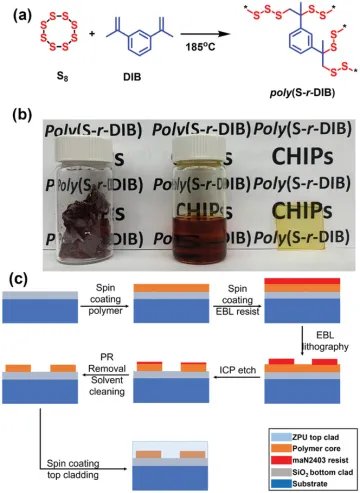Date Published: May 29, 2022
Optical polymer-based integrated photonic devices are gaining interest for applications in optical packaging, biosensing, and augmented/virtual reality (AR/VR). The low refractive index of conventional organic polymers has been a barrier to realizing dense, low footprint photonic devices. The fabrication and characterization of integrated photonic devices using a new class of high refractive index polymers, chalcogenide hybrid inorganic/organic polymers (CHIPs), which possess high refractive indices and lower optical losses compared to traditional hydrocarbon-based polymers, are reported.
These optical polymers are derived from elemental sulfur via the inverse vulcanization process, which allows for inexpensive monomers to be used for these materials. A facile fabrication strategy using CHIPs via lithography is described for single-mode optical waveguides, Y junction splitters, multimode interferometers (MMIs), and high Q factor ring resonators, along with device characterization. Furthermore, propagation losses of 0.4 dB cm−1 near 1550 nm wavelength, which is the lowest measured loss in non-fluorinated optical polymer waveguides, coupled with the benefits of low cost materials and manufacturing are reported. Ring resonators with Q factor on the order of 6 × 104 and cavity finesse of 45, which are some of the highest values reported for optical polymer-based ring resonators, are also reported.

a) Synthetic scheme for inverse vulcanization of 1,3-diisopropenylbenzene to form poly(S-r-DIB); b) digital images of poly(S-r-DIB) (left), poly(S-r-DIB) solution in chlorobenzene (center, c = 10 mg mL−1) and poly(S-r-DIB) thin film (2 µm) on a glass substrate; and c) schematic process for CHIPs device fabrication via spin coating and e-beam lithographic methods which utilized a high RI core of poly(S-r-DIB) layer (d = 450 nm) and a top cladding layer of ZPU (d ≈ 4 µm).
